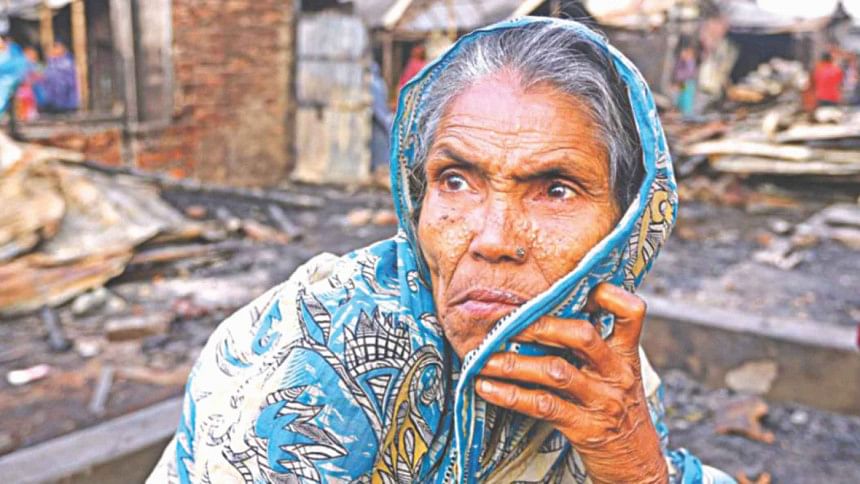Social protection needs more in next budget

The social protection allocation in the annual budget has consistently increased over the last 14 years. In FY 2008-09, a total of Tk 13,845 crore was allocated for social protection programmes. This allocation was 14.71 percent of the annual budget and 2.25 percent of the GDP. In the FY 2021-22 budget, Tk 107,614 crore was allocated for social protection programmes. It was 17.83 percent of the annual budget and 3.11 percent of the GDP. However, it has not been possible to cover all eligible people under different social protection programmes despite the sustained increase in budgetary allocations.
The number of households benefiting from social protection programmes in the country went up two and half times, from 12 percent in 2005 to 30 percent in 2020. The number of programmes has also gone up from 77 in FY 2009-10 to 130 in FY 2019-20. It is believed that the increased level of public funding has contributed substantially to poverty reduction in Bangladesh. However, there are still over 10 percent of people categorised as "extreme poor" in the country. This number has gone up since mid-2020, due to the onslaught of the Covid-19 pandemic. But due to paucity of reliable data, it is difficult to estimate the percentage of people living in poverty now. The government undertook cash and food distribution to assist the new poor. These were in addition to the regular social protection programmes which are aimed at reducing the social and economic vulnerabilities of the poor families.
There are about 130 social security projects and programmes in Bangladesh, the majority of which are small in size. Just a dozen of them employ almost 80 percent of the total social security budget. These projects and programmes can be mainly categorised in two different ways: 1. By sectors like health, nutrition, education, and infrastructure development, and 2. By life cycle, such as pregnancy and early age, school age, working age, and old age.
The government, under the leadership of the cabinet division, has developed the second phase of the Action Plan (2021-26) of the National Social Security Strategy (NSSS) to strengthen the overall efficiency and impact of social protection programmes. These programmes need to adopt appropriate targeting mechanisms to include the most deserving benefi-ciaries. Gradually, the government extended the payment of benefits through the Government-to-Person (G2P) system, using mobile financial services, for about 68 percent of total cash transferred. This has cut down corruption and is also cost-effective and time-saving.
After making significant progress on the payment aspect, the government is now focusing on the targeting side of social protection programmes. Identifying the most deserving beneficiaries is a challenge that needs to be resolved urgently for better utilisation of public resources. The government's recent decision of a universal cash transfer approach to improve the coverage of certain safety net programmes is a good one in this regard.
During the past two years, three programmes under the Department of Social Services have expanded coverage and introduced an online self-registration system to 112 poverty-stricken upazilas in 2020-21 and to 150 upazilas in 2021-22. The three programmes are Old Age Allowance, Allowances for the Widow, Deserted and Destitute Women, and Allowances for the Financially Insolvent Disabled.
Anyone who believes they are eligible for any of these allowances can apply for it through www.mis.bhata.gov.bd. The Social Welfare Officers and upazila, union and paurashava committees verify the information and recommend the enrolment of those eligible into the programmes. The government is planning to cover 100 additional upazilas under this universal approach in FY 2022-23.
These three programmes truly cover the most vulnerable groups in society and the universalisation of coverage was needed to cover all those who deserve to receive benefits. There are definite financial implications of universalisation and, therefore, the government needs to allocate an increased amount of resources for social protection in the 2022-23 budget to cover newer applicants. Historically, in the 262 upazilas where the universal approach has been introduced during the last two years, the number of beneficiaries has increased substantially. The Old Age Allowance covers 5.7 million beneficiaries now across rural and urban areas, which includes about 50 percent of the elderly population of the country. The number increased rapidly from 4.4 million in 2018. The Allowances for Widow, Deserted and Destitute Women currently benefit 2.47 million women, while about one million persons receive disability allowances.
In the future, other major social protection programmes should also adopt the universal approach, and a digital self-registration system should be introduced for improved targeting of beneficiaries.
Dr Nawshad Ahmed is an economist, urban planner, and an ex-UN official.

 For all latest news, follow The Daily Star's Google News channel.
For all latest news, follow The Daily Star's Google News channel. 








Comments